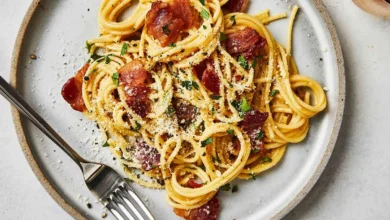Pasta, that beloved Italian staple, has captured the hearts and appetites of people worldwide. But did you know that there’s a pasta revolution happening in kitchens across the globe? Homemade pasta, with its infinite possibilities, is taking the culinary world by storm. This guide aims explore the art of crafting unique homemade noodle varieties, providing you with inspiration and techniques to become a pasta maestro in your own kitchen.
The Allure of Homemade Pasta

Before we delve into the creative process, let’s explore why homemade pasta is gaining such popularity. There’s an undeniable charm to crafting your own noodles. It allows you to control every element, from the type of flour to the thickness of the dough. Here are a few reasons why homemade pasta has become a culinary trend:
1. Quality Control
When you make your own pasta, you have complete control over the ingredients. You can use high-quality flour and fresh, local eggs, ensuring that your pasta is free from additives and preservatives. This results in a superior taste and texture that’s hard to achieve with store-bought options.
2. Endless Variety
With homemade pasta, you’re not limited to the standard shapes and sizes found in supermarkets. You can get creative with different flours, flavors and even colors to make unique pasta shapes that cater to your culinary imagination.
3. A Sensory Experience
Kneading and rolling out pasta dough can be a therapeutic experience, allowing you to connect with the food on a deeper level. The tactile nature of pasta-making engages your senses and offers a sense of satisfaction that’s hard to beat.
4. Impress Your Guests
Homemade pasta has a wow factor that can elevate your cooking to a whole new level. Whether you’re hosting a dinner party or preparing a romantic meal for two, serving homemade pasta is a surefire way to impress your guests.
Pasta Dishes: The Spice of Variety

1. Spaghetti Carbonara
A Roman classic made with eggs, cheese (typically Pecorino Romano), pancetta or guanciale, and black pepper.
2. Fettuccine Alfredo
A creamy sauce made with butter, heavy cream, and grated Parmesan cheese. Best served with wide and flat fettuccine noodles.
3. Linguine with Clam Sauce
A seafood delight featuring linguine noodles served with a flavorful white wine or tomato-based sauce and tender clams.
4. Penne alla Vodka
Penne pasta tossed in a creamy tomato and vodka sauce, often with a touch of red pepper flakes for some heat.
5. Lasagna
Layered pasta dish with sheets of lasagna noodles, ricotta cheese, ground meat (often beef or sausage), tomato sauce, and mozzarella cheese.
6. Ravioli with Sage Brown Butter Sauce
Stuffed pasta pillows filled with a variety of ingredients, served with a nutty, fragrant sage brown butter sauce.
7. Pappardelle with Wild Mushroom Sauce
Wide, ribbon-like pappardelle noodles paired with a rich and earthy mushroom sauce, often made with a mix of wild mushrooms.
8. Aglio e Olio
A simple yet flavorful dish featuring spaghetti tossed with olive oil, garlic, red pepper flakes, and fresh parsley.
9. Cacio e Pepe
A classic Roman pasta dish consisting of spaghetti, Pecorino Romano cheese, black pepper, and a bit of pasta water to create a creamy sauce.
The Basics: Making Homemade Pasta
Now that we’ve explored the allure of homemade pasta let’s get into the nitty-gritty of making it. To start your pasta revolution, you’ll need a few essential tools and ingredients:
Tools
1. Mixing Bowls: For combining your ingredients.
2. Pasta Machine: To roll and cut your pasta into desired shapes.
3. Rolling Pin: If you don’t have a pasta machine, a rolling pin will suffice.
4. Knife or Pasta Cutter: For shaping your pasta.
5. Clean Kitchen Towels: To cover and rest your dough.
6. A Flour Sifter: For dusting flour when rolling out the dough.
Ingredients
1. Flour: All-purpose or pasta-specific flour.
2. Eggs: Fresh and high-quality eggs are essential.
3. Salt: To enhance the flavor of your pasta.
4. Water: In some recipes, you might need a bit of water.
Step-by-Step Guide
Measure Ingredients: Begin by measuring your flour and salt. The most common ratio is one cup of flour to one egg, with a pinch of salt.
Create the Dough: In a mixing bowl, combine your flour and salt. Create a well in the center and crack the eggs into it. Slowly incorporate the flour into the eggs until a dough forms.
Knead the Dough: Turn your dough out onto a floured surface and knead it for about 5-10 minutes until it’s smooth and elastic.
Rest the Dough: Wrap your dough in plastic wrap or cover it with a clean kitchen towel and let it rest for at least 30 minutes. This allows the gluten to relax and makes rolling out the dough easier.
Roll Out the Dough: Use your pasta machine or rolling pin to roll out the dough to your desired thickness. Remember to dust with flour as needed to prevent sticking.
Cut and Shape: Use a knife or pasta cutter to shape your pasta. You can make classics like fettuccine or get creative with shapes like farfalle (bowties) or orecchiette (little ears).
Cook and Enjoy: Boil your homemade pasta in salted water for a few minutes until it’s al dente. Serve with your favorite sauce, and savor the fruits of your labor!
Getting Creative: Unique Pasta Varieties
Now that you have the basics down, it’s time to unleash your creativity and craft unique pasta varieties that will impress everyone at your table. Here are some ideas to get you started:
- Flavored Pasta: Infuse your pasta with exciting flavors by adding ingredients like spinach, beetroot, tomato paste, or even squid ink to your dough. These not only add vibrant colors but also a subtle taste that pairs beautifully with specific sauces.
- Stuffed Pasta: Experiment with stuffed pasta like ravioli or tortellini. Fill them with a variety of ingredients, such as ricotta and spinach, butternut squash, or a mix of cheeses and herbs.
- Herb-Infused Pasta: Enhance the aroma and taste of your pasta by adding fresh herbs like basil, thyme, or rosemary to your dough. The fragrance will infuse your dishes with delightful complexity.
- Gluten-Free Options: For those with dietary restrictions, try making gluten-free pasta using alternative flours like rice flour, almond flour, or chickpea flour.
- Unique Shapes: Get artistic with your pasta shapes. Try making intricate shapes like pappardelle, cavatelli, or fusilli using everyday kitchen tools or specialty pasta cutters.
Conclusion
Homemade pasta is a delightful and rewarding culinary adventure that allows you to create unique and delicious dishes right in your own kitchen. The pasta revolution is here, and it’s all about creativity, quality, and the joy of crafting something truly special. So, roll up your sleeves, dust off that rolling pin, and start experimenting with homemade pasta to elevate your dining experiences to new heights. Your taste buds will thank you for it, and you’ll never look at store-bought pasta the same way again. Bon appétit.



